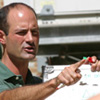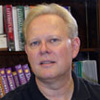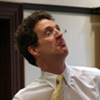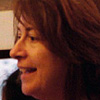In the classroom: Excellence in teaching
Related content:
Excellence in teaching: Driving students beyond the boxes.
The following reflections on excellence in the classroom have been expressed by professors at the College in articles previously published by the W&M News. —Ed.
Integrating cross-disciplinary strengths
 There is a synergy between teaching and scholarship. We (Sarah Stafford and him) are both active researchers and productive scholars, and our scholarship strengthens our teaching and vice versa. There is an additional synergy when you have folks from overlapping but distinct disciplines addressing similar problems and issues from their unique perspectives … .”
There is a synergy between teaching and scholarship. We (Sarah Stafford and him) are both active researchers and productive scholars, and our scholarship strengthens our teaching and vice versa. There is an additional synergy when you have folks from overlapping but distinct disciplines addressing similar problems and issues from their unique perspectives … .”
(see Professors team up to teach law and economics)
Need to talk about teaching
 We need to talk about teaching more. I was at a university in the Midwest. What
I did was give them a series of questions that I get asked. You have a large
class: What steps can you take to involve a large class? Are you willing to be
innovative in a small class, and how would you define being innovative? These
were not shy professors, and many of them really disagreed with each other. I’m
not sure which ones were right, but afterward, a whole bunch of them got back
to me and said, “That’s the first vigorous discussion we’ve had about those
issues. And it was great. It didn’t resolve anything, I’m not sure it changed
my mind, but it was a real eye-opener. I thought everybody did what I did.”
We need to talk about teaching more. I was at a university in the Midwest. What
I did was give them a series of questions that I get asked. You have a large
class: What steps can you take to involve a large class? Are you willing to be
innovative in a small class, and how would you define being innovative? These
were not shy professors, and many of them really disagreed with each other. I’m
not sure which ones were right, but afterward, a whole bunch of them got back
to me and said, “That’s the first vigorous discussion we’ve had about those
issues. And it was great. It didn’t resolve anything, I’m not sure it changed
my mind, but it was a real eye-opener. I thought everybody did what I did.”
—Paul Marcus
(see Marcus receives Virginia Outstanding Faculty Award)
 Tricky technology
Tricky technology
It’s tricky to use technology as a teaching tool well.
Because there’s a tendency to think it’s a magic bullet in some sense. I think
the tools are getting easier to use, and it’s an exciting time to try to adapt
the Web 2.0-approach to learning.
(see Patterson receives Virginia Outstanding Faculty Award)
 Students as cultural agents
Students as cultural agents
I'm a big believer in cultural agency. ... I think we are capable of employing culture, employing education to build tolerance, foster understanding, foment creativity and, granted, to a limited extent—because I'm also not going to say my students and I are changing the world in a big way, but I do think we can make a difference. As an educator, it's important to me to empower students to see themselves as cultural agents.
(see Stock: On Location in Cuba)
Number 1 source of inspiration
![]() My students: They are the number one source of inspiration. They’re
so talented. They come in when I teach the composition classes. Even last
night, one student came in , he wrote an entire piece from a single sine wave, and it just sounded
beautiful, and he was a physics major, so everything was mathematical.
My students: They are the number one source of inspiration. They’re
so talented. They come in when I teach the composition classes. Even last
night, one student came in , he wrote an entire piece from a single sine wave, and it just sounded
beautiful, and he was a physics major, so everything was mathematical.
 Actively tackling issues
Actively tackling issues
As an undergraduate, I sat through far too many lectures that were
passive. The professor stood at the front and read through his or her
notes. I try to be much more enthusiastic and interactive
with students, even in large intro classes. I want to get them up,
asking and answering questions, volunteering for demos and actively
discussing the issues that we’re tackling that day.
—Rowan Lockwood
(see Lockwood receives Jefferson Teaching Award)
 Respect and good humor
Respect and good humor
I still remember what it was like as an undergraduate and graduate student. I had some very good teachers myself and try to remember what I valued in them in terms of being treated fairly and honestly and with respect and with a certain amount of good humor, as well.
—Chris Howard
(see Two professors receive outstanding faculty awards)
 Students require fuller answers
Students require fuller answers
Because I've always loved learning, I continue to learn. Even in a class that I may have taught year after year for 20 years, I still find things that are new. Students will ask a question, and I'll realize I don't actually know a good, deep answer to that, and so I'll have to go and learn more, come back to them and say, "Here is a fuller answer."
—Liz Allison
(see Two professors receive outstanding faculty awards)
 Pointing toward assumptions
Pointing toward assumptions
[I came to William and Mary because] I wanted a step up in career and quality of institution, but I especially liked the combined emphasis on teaching and research here. I put my heart into teaching. I wanted to go to a place that would value that. [Concerning students] I want to help them see where their own assumptions are. Sometimes we go through life not realizing how much we're made up of our culture, our surroundings.
—Ravi Gupta
(see Gupta recounts papal meeting)
 Creating knowledgable people
Creating knowledgable people
The students here are probably the most knowledgable people in the world on trying to code a huge data set like this. [Students working with PLAID have coded] over a million records now.
—J. Timmons Roberts
(see PLAID: Creating a worldclass database)
 Student-researchers learn to walk
Student-researchers learn to walk
We have always tried to get students into the laboratory as soon as they think they are able. Sometimes they're not able; it's like a child learning to walk. A kid stands up and begins to take a few steps, you want to encourage that and try to make that possible. ... I think you're never really ready to do research. You just jump in and you do it, and pretty soon you get good at it.
—Dennis Manos
(see Manos: The research imperative at W&M)
 Librarians couple research and teaching
Librarians couple research and teaching
In many ways, librarians are researchers. It's coupled with that teaching element, to help a student or faculty member, they have to engage in research to figure out what is the best approach. But rather than just saying here they are, there is that help side, saying here is how you locate materials.
—Connie McCarthy
dean of libraries
(see McCarthy: 21st-century Swem)
Curiosity of the mind
You try to bring the qualities of liberal-arts education that have
existed since we've had records of liberal-arts education. You try to
encourage curiosity of mind. You try to encourage high standards. You
try to get to know each student one by one and not by stereotype. You
try to know them in later life and follow their careers You see
yourself at ages 18 to 22 in them.
—David Holmes
professor of religious studies
(see Holmes honored with Jefferson Award)
 Creek leaping
Creek leaping
I fondly recall the camaraderie that I shared in college and graduate school with my advisor and fellow students. Today, I feel similar kinship in the field or in my lab when an undergraduate advisee and I leap across a tidal creek in a muddy marsh or when my graduate students and I celebrate getting a real-time wave sensor back on line after it has mysteriously crashed. Basically I strive to give my students opportunities for experiences similar to the best I had that instilled within me such devotion to teaching, mentorship and discovery.
—Carl Friedrichs
VIMS professor of physical sciences
(see Friedrichs receives Virginia Outstanding Faculty Award)
 Kidding in the classroom
Kidding in the classroom
Kidding points to something more and less serious; that the classroom is a place for play as well as seriousness, and that in that spirit students can try out ideas. Another way to put it is that we want to open the student's imagination. Art, of course, is all about imagination; but it also can be an occasion for imaginative thinking.
—Alan Wallach
professor of art and art history
(see Wallach to Williams next semester)
 Toward reasoned communication
Toward reasoned communication
It’s the process the students have to learn. When they get out of school and face a particular legal or business situation, they’re not going to remember the particular details of Kant’s third formulation of the categorical imperative, but if they have learned the process of evaluating a problem from this very distinctive point of view, that’s something that is worth teaching.
A conductor doesn’t make any music, but he or she brings it out and harmonizes it and gets the voices to speak to each other.
—Alan Fuchs
professor of philosophy
(see Toward reasoned communication)
 Initiative of students
Initiative of students
From the beginning, we have counted on the initiative of the students to chart the way, and we've tried to come along as egalitarian guides. Certainly I couldn't do this work. It takes the energy and stamina and enthusiasm, the commitment and dedication, that the students bring to the effort.
It involves a kind of teaching—hands-on, face-to-face, outside the classroom—that I've always valued. I think that the building-block, stair-step approach to higher education is being challenged. I don't think the former method is fundamentally wrong. I just think we're finding that there are other ways of doing things that are extraordinarily rich and productive.”
—David Aday
professor of sociology
(see Aday ponders civic-engagement success)
 Saha: Science as liberal arts
Saha: Science as liberal arts
I want to produce educated citizens for
the 21st century who are knowledgeable about everything that is going
on around them. ... I don't think that
being at a liberal-arts institution affects the way I would teach a
science course. I would like to think that the way I would
teach would be the way anybody would teach at Stanford or Cal Tech or
MIT.
—Margaret Saha
professor of biology
(See Driving students beyond the boxes)
 A catalyst and a mentor
A catalyst and a mentor
I am a catalyst. What a good teacher does is kind of catalyze thinking and productivity in students. Teaching is not something in which you have a student sit at your feet while you dispense wisdom down to them and they soak it into their heads. You try to help them become original, creative people. …
It was Athena, the goddess, who came to [Odysseus’ son] in the form of Mentor. She could have come to him as Athena and said, “Look, I’m a goddess. Do this, do this and do this; this is the way to handle things.” That would have been self-defeating. She came as a mentor, a mortal. That's the model of what a good mentor is: someone who is respected, can facilitate, can catalyze. The measure of a mentor's success is the independence of the student, not the continuing dependence.
—Joel Schwartz
director, Charles Center
(see Schwartz receives Thomas Jefferson Award at Charter Day)
 Teaching conversations
Teaching conversations
There are times when we play the expert as we stand up in front of a class and deliver a lecture. But there are also plenty of times when we converse with students, when we engage in a dialogue about what matters and why. … I think it is then, when we drop the “expert” role and really engage our students one-on-one that most of the teaching and learning take place. Ideally, we’re not just telling students what we know and what we think they need to hear. We’re encouraging them to practice the best way to learn and to keep learning for the rest of their lives.
—Laurie Koloski
associate professor of history
(see Teaching as conversation)
 Playwriting in progress
Playwriting in progress
What's happening is that students are bringing in bits and pieces of their plays as they are being written and getting feedback as they go along. That's why I wanted to create this playwrights' forum, where there's this constant showing of their work with a constant feedback. They get a sense of where they're going as they write. They dialogue with themselves as they work toward their final projects. They are learning playwriting in progress.
—Laurie Wolf
assistant professor of theatre
(see Playwrights' playground)
 Trading energies
Trading energies
Teaching gives me the freedom to be involved more in my work, and I can bring that level of energy to the classroom. The students then benefit from having an active professor and, in turn, they challenge and inspire me to be a better teacher. It is a give-and-take relationship.
—Lewis Cohen
professor of art and art history
(see Muscarelle exhibition to honor Cohen)
 The discipline of learning
The discipline of learning
I am trying to teach students how to think, and since they have very little experience, they find it very demanding. Mostly they’re expected to memorize, to get what’s in the book, to get what’s in the lecture and to give it back. As they come here, mostly their model for learning has been as if they’ve had a funnel on top of their head—information is poured in and they’re expected to spit some of it back out. I think of learning as acquiring skills. These are difficult skills. I can compare it to mountain climbing, such as I’ve seen in Colorado, where people were working together to scale a vertical wall. The wall was not very high at all. They were just practicing how to go up it. The discipline itself is learning how to do it so they can go to any mountain and make some progress.
We can learn on our own, and we can learn in groups. I find that there are things that happen in learning together that don’t seem to happen by myself. When you work together on a problem, the fact that you have another to rely on—it’s cooperative, just like that mountain thing—means that both can get somewhere. I’ve noticed that when the students ask the best, most-discerning kinds of questions, it brings out the best in me. Things I haven’t really focused on are impressed upon me, and I’ll have to come up with something. So it is good for me, and I hope it is good for them.
—Hans Tiefel
emeritus professor of religious studies
(see Pessimism, politics and joy)
 Not the Oprah approach
Not the Oprah approach
One of the first things I say in pretty much any class is that as much as I like Oprah, we’re not going to teach the Oprah Winfrey approach, where we’re just going to talk about how we feel about this. Sociology is a social science … , and we approach things scientifically. It’s not just this field of study. It’s something people do for a living, and there are a lot of choices to be made. You could make good choices; you could make bad choices.
—Thomas Linneman
associate professor of sociology
(see A passionate approach)
 Three-pronged approach
Three-pronged approach
Newly hired faculty in arts and sciences always are cautioned not to get too heavily committed to service during their first three years. Unfortunately, that might become a habit that is hard to break. Try to do all three. Try to do not only excellent teaching, which is a full-time job, but also do scholarship, because we need faculty involved in current scholarship to be role models for our students. And do some degree of service, which is very rewarding inasmuch as it helps make our community a better place.
—James McCord Jr.
associate professor emeritus of history
(see McCord receives College’s highest honor)
 Showing and generating questions
Showing and generating questions
My emphasis is a lot more about showing students how we approach problems as scientists, showing them how we generate questions and go about answering these questions through the collection of data. It’s much more about the process of doing science and geology, and I think that’s what students get excited about. We try to do original things where students are collecting their own data, and I think they get a better feeling about doing real work that’s not made up.
—Gregory Hancock
associate professor of geology
(see Hancock leads through geology’s larger classrooms)
 Tapping into the classroom
Tapping into the classroom
I believe from the very first day the very first thing that you say in the class sets the tone for your class. If you want to build a community, you have to be a very inviting teacher who sets up a world in which people want to come and learn with you—not just learn from you but learn with you, and who believe that they can bring something to you that you don’t know or haven’t thought about. If you think of a classroom of 35 students from various backgrounds, imagine what they bring. Teachers should be excited by that. Think of what a classroom of 20 William and Mary seniors and graduate students bring. Tapping into that shared knowledge remains extremely exciting.
—John Noell Moore
associate professor of education
(see Moore ‘constructs’ communities of classrooms)
 Humor works
Humor works
When I started studying humor, I said to myself, “This is a gold mine for teaching!” It allows the students to relax. When you joke about stuff, people don’t have the view that there is a set body of things they have to learn that day, so discussions go much easier. When I first used it in the classroom, the students were kind of looking at each other and looking at me like, “Is this really part of our class or what?” But after they could laugh, then they could talk. So humor works as an icebreaker, as a way of reducing tension and allowing people to express themselves.
—John Morreall
professor of religious studies
(see Tuition serves as cover charge)
 Learning engagement
Learning engagement
I love many things about William and Mary, but I think the first thing that comes to mind is the students. The capability of the students, their desire to learn, not just to get a grade but their desire to experience something different, to make sense of it, to engage in the world in a really sophisticaed way, is remarkable. They are not just passive learners, they are active learners. I relate to that.
—Ann Marie Stock
associate professor of modern languages and literatures
(see Professor Stock encourages a class mutiny)
 Point of knowledge
Point of knowledge
One thing I do is to have the class play out drum rhythms on the desks. You can watch how it all, without any organizing principle, disassociates into chaos, but when you put back the organizing principle—that would be me—it all focuses back into rhythm. You have music. I talk a lot about literature, about books, about movies—whatever strikes my fancy. I try not to be myopic. I try to find things that have resonance, where everything is tied together and where human thought—whether it’s art or science—is all coming to the same story.
—Carey Bagdassarian
assistant professor of chemistry
(see Bagdassarian gets TJ award)
 Quixote’s dream
Quixote’s dream
One never stops to ponder, when eating an orange, where the orange came from. After students have served on the Eastern Shore, and they see what the farm workers are doing, they always—most of them—are able to look at the piece of fruit and think that the second-to-last-pair of hands that touched these were those of a migrant farm worker. It makes them that much more aware.
[Translating for migrant workers] can place students under stress. They see poverty up close, and it can get under their skin. I may tell them, “Don Quixote does a lot of things that are goofy and foolish, but he also creates, almost by accident, incidental good that occurs because of the dream that he can sort of change the world.” So, I tell students when they say they are overwhelmed, “When was Don Quixote overwhelmed? When did he give up? He’s been beaten countless times, hurt all the time, and hungry, but he never gives up.”
—Jonathan Arries
associate professor of modern languages
(see Quixote-quoting professor)
 Skip to main content
Skip to main content

